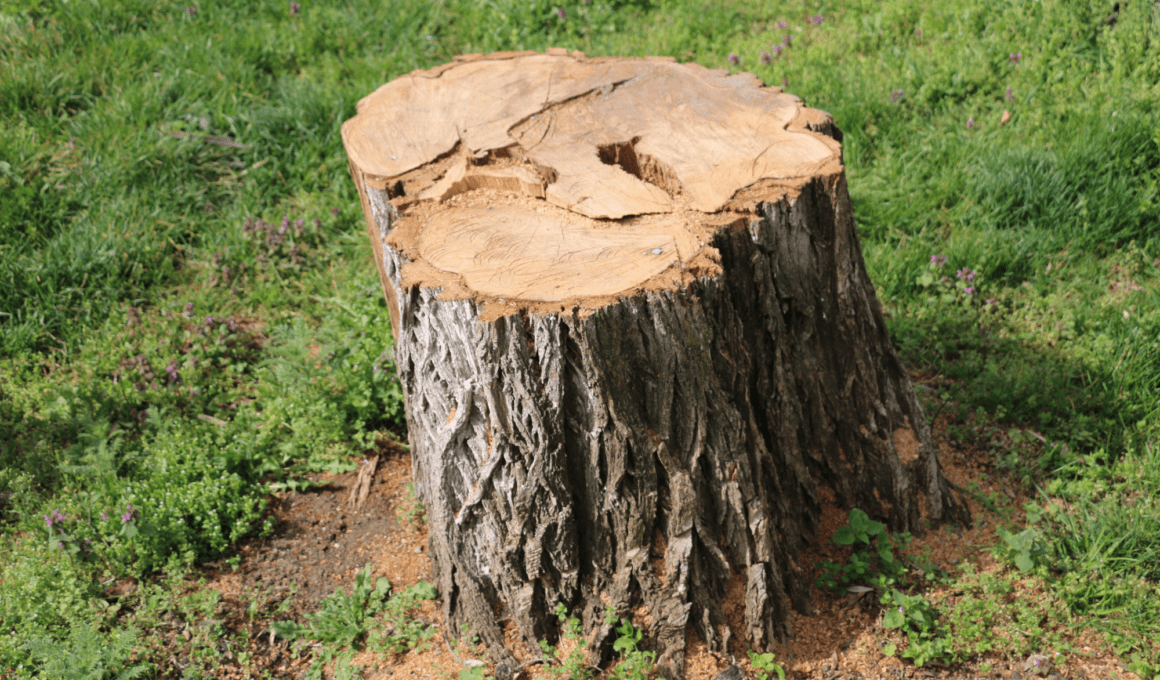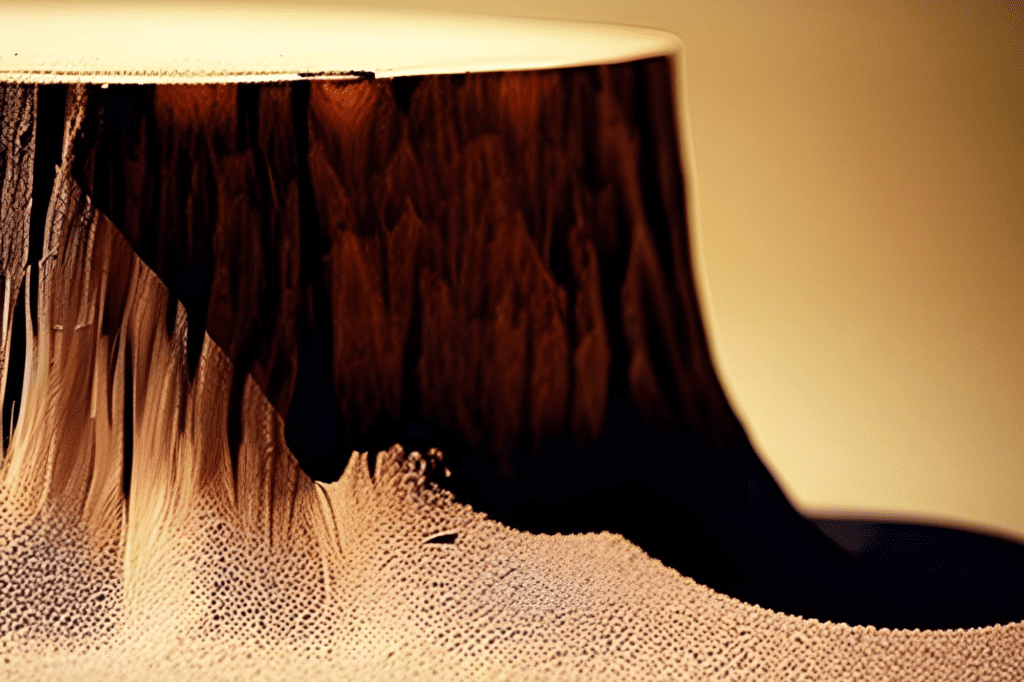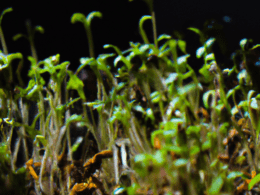Are you looking for a way to repurpose those old tree stumps in your backyard? Well, look no further! In this article, we will guide you through the process of treating and sealing tree stumps for outdoor use.
By following these steps, you can transform those stumps into functional and safe additions to your outdoor space.
First, assess the condition of the stump to ensure it is sturdy and free from any rot or decay.
Next, remove any excess wood and debris to create a smooth surface.
Treat the stump with a preservative to protect it from insects and decay. Allow sufficient time for the preservative to dry before moving on to the next step.
Once the stump is dry, sand and smooth the surface to prevent splinters and create a more attractive appearance.
Apply a protective sealant to further enhance its durability and weather resistance. If desired, you can also add stain or paint to match your outdoor decor.
Lastly, consider adding functional elements such as a tabletop or seating to make the stump even more useful.
With these steps, you can ensure the safety and longevity of your treated and sealed tree stumps for outdoor use.
Quick Summary
- Assess the condition of the tree stump for stability and signs of decay
- Treat the stump with a preservative to protect against insects and decay
- Sand and smooth the surface of the stump to prevent splinters and enhance appearance
- Apply a protective sealant to shield the stump from moisture, UV rays, and pests
Assess the Condition of the Stump
You should carefully examine the condition of the stump before proceeding with any treatment or sealing. Safety should always be a top priority when working with outdoor materials.
Assessing the stability of the stump is crucial to ensure it’s safe for use. Look for any signs of decay, such as soft or rotten areas, fungal growth, or hollow spaces. These signs indicate a weakened structure that may not be suitable for outdoor use.
Start by checking the overall stability of the stump. Give it a gentle shake to see if it wobbles or feels loose. This could be a sign of root damage or decay, making it unsafe to seal.
Next, inspect the exterior for any visible signs of decay. Look for soft spots, discoloration, or areas that have been eaten away by insects. These may indicate deeper issues that need to be addressed before proceeding.
Additionally, examine the base of the stump for any signs of fungal growth. Fungi can cause extensive damage to the wood, compromising its strength and stability. If you notice any mushrooms or other fungal formations, it’s important to address this before sealing the stump.
By carefully assessing the stability and signs of decay, you can ensure that the tree stump is safe to be treated and sealed for outdoor use. Remember, prioritizing safety is key when working with outdoor materials.
Remove any Excess Wood and Debris
Clear away any remaining wood chips and debris from the stump to ensure a clean surface for further treatment. It’s important to properly prepare the stump before sealing it for outdoor use.
Here are some steps to follow when cleaning debris from the stump:
- Use a rake or broom to sweep away loose wood chips and dirt from the surface of the stump. This’ll help prevent any potential accidents or injuries when working on the stump.
- Use a brush or vacuum cleaner to remove smaller debris and dust from the crevices and cracks in the stump. This’ll ensure that the surface is smooth and ready for treatment.
- If there are any larger pieces of wood or branches sticking out of the stump, use a saw or pruning shears to carefully trim them down. This’ll create a more uniform and neat appearance.
By thoroughly cleaning the stump and removing any excess wood and debris, you’re creating a safer environment for yourself and others. It also allows for better adhesion of any sealants or treatments that you may apply to the stump. Remember to always wear protective gloves and eyewear when working with wood and tools. Safety should always be a top priority when treating and sealing tree stumps for outdoor use.
Treat the Stump with a Preservative
Once the excess wood and debris have been removed, it’s time to give the stump a protective treatment. This step is crucial to ensure the longevity and safety of your outdoor project.
Start by using a wood filler to fill in any cracks or holes on the surface of the stump. This will help prevent water from seeping in and causing rot. Make sure to choose a high-quality wood filler that’s designed for outdoor use. Apply the filler according to the manufacturer’s instructions, making sure to smooth it out and blend it with the surrounding wood.
After the wood filler has dried, it’s time to waterproof the stump. This’ll provide an extra layer of protection against moisture, insects, and decay. Choose a waterproofing product that’s suitable for outdoor use and follow the application instructions carefully. Apply the waterproofing solution evenly over the entire surface of the stump, using a brush or roller. Make sure to cover all areas, including the cracks and crevices. Allow the waterproofing solution to dry completely before moving on to the next step.
By treating the stump with a wood filler and waterproofing it, you’re taking important steps to protect it from the elements. This’ll help ensure that your outdoor project remains safe and durable for years to come.
Allow Sufficient Time for the Preservative to Dry
Make sure to give the preservative enough time to dry completely before moving on to the next step, so that the protective layer can effectively safeguard your stump from potential damage. Proper drying time is crucial to ensure that the preservative is fully absorbed and forms a strong barrier against moisture, insects, and decay.
Here are some important points to consider during the drying process:
- Allow at least 24 hours for the preservative to dry before exposing the treated stump to any moisture or outdoor elements. This will ensure that the preservative has enough time to penetrate the wood fibers and create a durable protective layer.
- Keep the stump in a well-ventilated area during the drying process. Good air circulation will help expedite the drying time and prevent the buildup of moisture, which can compromise the effectiveness of the preservative.
- Avoid touching or leaning anything against the treated stump while it’s drying. This can disrupt the drying process and potentially cause the preservative to smear or become unevenly distributed.
By following these guidelines, you can ensure that the preservative application is successful and that your tree stump is properly sealed and protected for outdoor use. Remember, patience is key when it comes to drying time, as it directly affects the long-term durability and effectiveness of the treatment.
Sand and Smooth the Surface of the Stump
To achieve a polished finish, it’s essential to sand and smooth the surface of your stump before moving forward. This step is crucial for both aesthetic and safety reasons.
Sanding the stump helps to remove any rough edges or splinters that could potentially cause injury. It also provides a smooth surface for any additional treatments or finishes you may apply. Start by using a coarse-grit sandpaper to remove any bark or uneven surfaces. Be sure to wear protective gloves and eyewear to keep yourself safe.
Once the rough areas are smoothed out, switch to a finer grit sandpaper to further refine the surface. Take your time and be thorough in your sanding, paying attention to any intricate details or crevices.
Sanding the stump is especially important if you plan on stump carving or creating creative stump designs. A smooth surface will make it easier to carve intricate patterns or designs into the wood. It will also allow the finished carving to stand out and be appreciated for its beauty.
Remember, safety should always be a priority when working with outdoor elements like tree stumps. Taking the time to sand and smooth the surface will not only enhance the appearance of your stump but also ensure that it is safe to use and enjoy in your outdoor space.
Apply a Protective Sealant
Now that you have sanded and smoothed the surface of the stump, it’s time to take the next step in treating and sealing it for outdoor use. Applying a protective sealant to the stump is crucial to ensure its longevity and durability against the elements.
A protective sealant acts as a barrier, shielding the stump from moisture, UV rays, and pests that could potentially cause damage. It not only enhances the appearance of the stump but also helps to prevent rotting and decay, making it safe for you and your family to enjoy in your outdoor space.
When choosing the right sealant for your stump, it’s essential to consider the specific needs of your environment and the type of wood you are working with. Some sealants are designed for specific wood types, while others offer a universal application. It’s important to select a sealant that is water-resistant, UV-resistant, and has mold and mildew protection.
To help you understand the importance of a protective sealant, take a look at the table below:
| Protective Sealant Benefits | Choosing the Right Sealant for Your Stump |
|---|---|
| Shields against moisture | Consider the specific wood type |
| Protects from UV rays | Look for water-resistant properties |
| Prevents rotting and decay | Ensure it is UV and mold-resistant |
By choosing the right sealant and applying it to your sanded and smoothed stump, you can ensure that it remains safe and intact for years to come.
Enhance the Appearance with Stain or Paint
Transform your stump into a stunning focal point by adding a pop of color with a vibrant stain or paint. Not only will this enhance its appearance, but it’ll also provide an extra layer of protection against the elements.
When selecting a stain, make sure to choose one that’s specifically designed for outdoor use and is labeled as waterproof. This’ll ensure that it can withstand rain, snow, and other weather conditions without fading or peeling.
Before applying the stain or paint, it’s important to properly prepare the stump. Start by cleaning it thoroughly with a brush and water to remove any dirt or debris. Once it’s clean and dry, you can begin the application process.
Using a brush or roller, apply the stain or paint in thin, even coats, following the manufacturer’s instructions. Be sure to cover the entire surface of the stump, including any cracks or crevices, to ensure uniform coverage.
After applying the first coat, allow it to dry completely before applying additional coats if needed. This’ll help to achieve a more vibrant and long-lasting color. Remember to always work in a well-ventilated area and wear protective gloves and eyewear when applying the stain or paint.
By following these steps and selecting the right stain or paint, you can transform your tree stump into a beautiful and durable outdoor feature.
Add Functional Elements for Outdoor Use
Enhance your outdoor space by incorporating functional elements into your tree stump, creating a practical and stylish addition. By adding functional design elements, you can transform a simple stump into a useful piece of furniture or a decorative element. Here are some ideas to consider:
| Functional Elements | Benefits |
|---|---|
| Tree stump table | Provides a flat surface for placing drinks, snacks, or decorative items. It can also serve as a seating option. |
| Tree stump planter | Allows you to display your favorite plants and flowers while adding a touch of natural beauty to your outdoor space. |
| Tree stump stepping stones | Creates a unique pathway through your garden or yard, adding texture and charm. |
| Tree stump bird bath | Attracts birds to your outdoor space, providing them with a water source while adding a decorative touch. |
| Tree stump lantern holder | Adds a rustic and cozy ambiance to your outdoor area by holding lanterns or candles. |
When incorporating these functional elements into your tree stump, it is important to ensure their weather resistance. Consider using weather-resistant materials such as treated wood, metal, or durable paint to protect the stump from the elements. Regularly inspect and maintain these functional elements to ensure they remain safe and secure. By incorporating these ideas and prioritizing safety, you can create a functional and stylish addition to your outdoor space.
Frequently Asked Questions
Can I use any type of wood preservative on the tree stump?
Yes, you can use different wood preservatives on the tree stump. However, it is important to choose a preservative that is safe for outdoor use and follow the instructions carefully. Consider alternative treatments as well.
How long does it typically take for the preservative to dry?
To properly apply wood preservative to a tree stump, follow the manufacturer’s instructions and allow it to dry completely. To determine if it has fully dried before sealing, touch the surface and ensure it is no longer tacky or sticky.
What type of protective sealant should I use?
To protect and seal tree stumps for outdoor use, you should consider using a protective sealant. There are various options available, such as wood sealers or outdoor varnishes. These sealants provide a barrier against moisture, rot, and insect damage, ensuring the safety and longevity of the stumps.
Can I stain or paint the tree stump before applying the protective sealant?
When treating and sealing tree stumps for outdoor use, it is best to apply the protective sealant first before staining or painting. This ensures maximum protection against decay and weather damage.
What are some examples of functional elements that can be added to the tree stump for outdoor use?
You can add functional elements like outdoor seating or planters to the tree stump for outdoor use. These additions provide both functionality and safety, allowing you to enjoy your outdoor space while maintaining a secure environment.
Conclusion
In conclusion, treating and sealing tree stumps for outdoor use is a simple and effective way to enhance their durability and appearance. By assessing the condition, removing debris, and applying a preservative and sealant, you can ensure that the stump will withstand the elements and remain in good condition for years to come.
Don’t forget to sand and smooth the surface, and consider adding functional elements or a touch of paint or stain to make it truly unique. So go ahead and transform that old tree stump into a beautiful and functional addition to your outdoor space.










